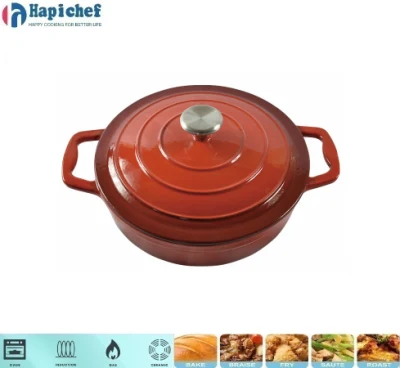dutch oven material
Understanding Dutch Oven Materials A Comprehensive Guide
Dutch ovens are beloved culinary tools known for their versatility, durability, and ability to retain heat. They come in various materials, each offering unique benefits and characteristics that can significantly influence your cooking experience. This article will explore the different materials used to make Dutch ovens and help you understand which one might be best suited for your culinary needs.
Cast Iron
The most traditional material for Dutch ovens is cast iron, renowned for its excellent heat retention and distribution properties. Cast iron Dutch ovens are incredibly versatile; they can be used on the stovetop, in the oven, or even over an open flame. When properly seasoned, a cast iron Dutch oven develops a natural non-stick surface, making it ideal for various cooking methods, from browning meats to baking bread.
However, cast iron is heavy and requires maintenance to prevent rust and maintain its seasoning. Newer options, such as enameled cast iron, provide a convenient solution. These Dutch ovens feature a glass-like coating that eliminates the need for seasoning while allowing for easy cleaning.
Enameled Cast Iron
Enameled cast iron Dutch ovens have gained immense popularity due to their vibrant colors and low maintenance requirements. The enamel coating prevents rust and does not require seasoning, making these pots user-friendly for beginners. They are perfect for slow-cooking, braising, and baking, giving a beautiful presentation right from oven to table.
The downsides are that enameled cast iron can be more expensive than traditional cast iron and may chip if mishandled or dropped. However, when cared for properly, they can last a lifetime and serve as a stunning addition to your kitchen.
dutch oven material

Stainless Steel
Stainless steel Dutch ovens are another excellent option, particularly for those who prefer a lighter-weight alternative. They heat up quickly and evenly, making them ideal for tasks that require precision cooking. Unlike cast iron, stainless steel does not react with acidic foods, allowing you to cook tomatoes and other acidic ingredients without concern.
The downside is that stainless steel doesn’t offer the same heat retention as cast iron. As a result, it may not be the best choice for low-and-slow cooking methods. However, for sautéing, simmering, and boiling, stainless steel Dutch ovens excel.
Aluminum
Aluminum Dutch ovens are lighter and typically less expensive than their cast iron counterparts. They conduct heat well, providing good cooking performance for everyday tasks. However, most aluminum Dutch ovens lack the heft and heat retention needed for slow cooking, which is often why many home cooks prefer cast iron options.
Anodized aluminum Dutch ovens can provide durability and a non-reactive surface, making them suitable for various cooking needs. Still, they may not deliver the same depth of flavor that slow-cooked meals in cast iron tend to achieve.
Conclusion
Choosing the right material for your Dutch oven is essential, as it impacts cooking performance and outcomes. Cast iron and enameled cast iron are ideal for those seeking durability and long-lasting results, while stainless steel offers versatility and ease of use for various cooking methods. Aluminum may be suitable for lighter cooking tasks and budget-conscious shoppers. Ultimately, understanding each material's strengths will empower you to select the perfect Dutch oven tailored to your culinary preferences. Whether you’re a seasoned chef or a home cook, the right Dutch oven can elevate your cooking experience.
-
Why Every Kitchen Needs a Casserole Cast Iron DishNewsJun.24,2025
-
Experience the Tradition and Quality of Cast Iron CookwareNewsJun.24,2025
-
Double Sided Cast Iron Grill PanNewsJun.24,2025
-
Cast Iron Dutch Ovens You’ll Actually UseNewsJun.24,2025
-
Buy Cast Iron Griddle for Everyday CookingNewsJun.24,2025
-
Barbecue Iron Grill Cooking PowerNewsJun.24,2025
-
Standard Product Lines from Cast Iron Cookware SuppliersNewsJun.11,2025
